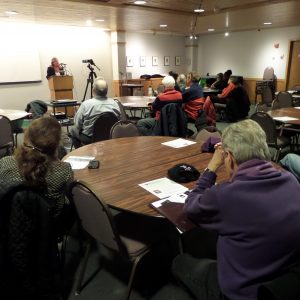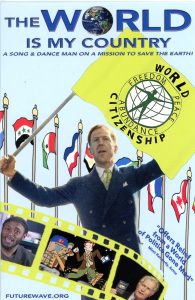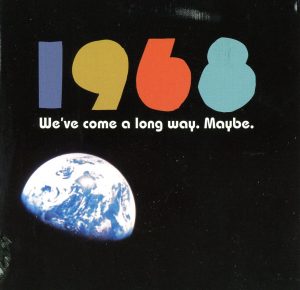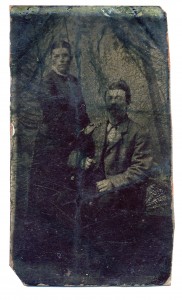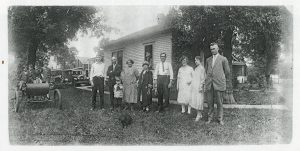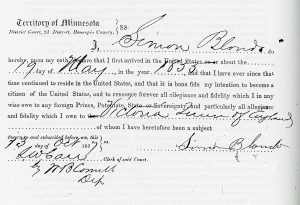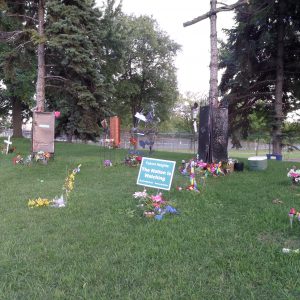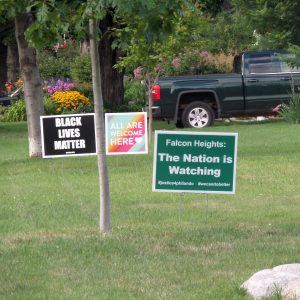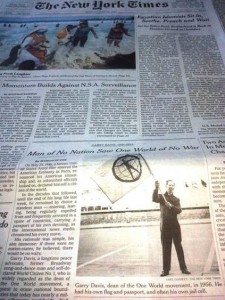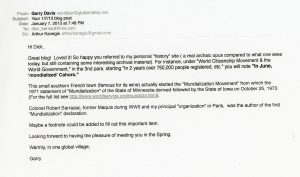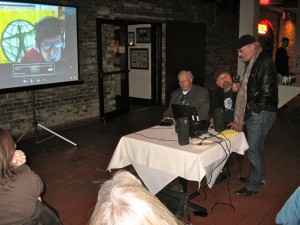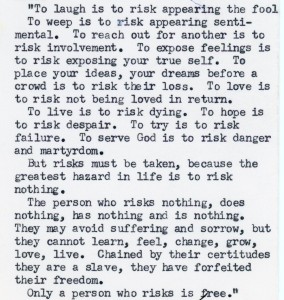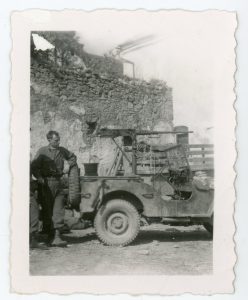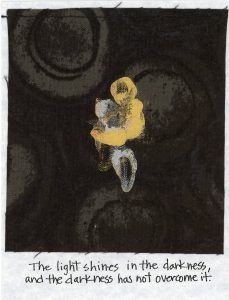“SNIP” Feb. 27: “We decided on a menu of macaroni & cheese with tuna and peas, spaghetti and a carrot/yellow squash combo and apples. I started the meal and all at once was joined by a woman from Honduras who really knew how to cook. I speak basically no Spanish but could understand very well that I had not cooked the vegetables correctly. We were then joined by a woman from Brazil so none of us spoke each others language but we all knew the language of human.”
NOTE FROM DICK BERNARD: A long and very powerful witness to the less publicized side of our neighbors in Mexico and Central America by retired teacher, Donna Krisch. (She and I “share” North Dakota roots, and an Aunt, long deceased.) I hope this essay diary of two weeks in El Paso is shared broadly. All photos, excepting Statue of Liberty, by Donna Krisch, click on any to enlarge. Guest columns, such as Donna’s, are always welcome here. dick_bernardATmsnDOTcom for information.
DONNA KRISCH
Wednesday February 15, 2017
Today four Basilica of St. Mary (Minneapolis MN) members plus myself will leave for El Paso Texas to help in a shelter on the Mexico/Texas border. We have two nurses in our group and the rest of us will help however we can. The people coming to the shelter are seeking asylum from violence in their own countries. We have heard most are coming from the countries of Guatemala, El Salvador and Honduras.
Thursday, February 16, 2017
We arrived in El Paso yesterday afternoon. During our stay we will be staying at a beautiful, old convent of the Loretto Sisters directly across the alley from the shelter where we will be working.
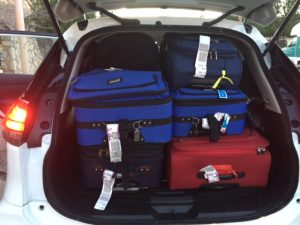
Arriving at El Paso
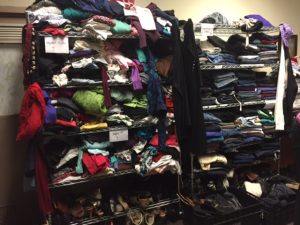
Clothing room at the shelter
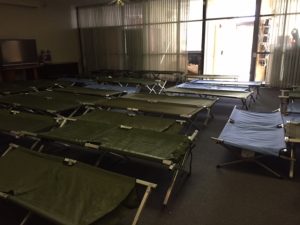
Dormitory for volunteers
When we arrived at the shelter a
Brazilian woman with two small children was being taken to the airport to catch a flight to Boston to meet family having spent the night at the shelter. The morning was spent getting a tour of the facility, and sorting clothes that were collected by the Basilica children. In the afternoon, we met with Eina Holder, director of the shelter. She gave us a brief history of the shelter and an update on what we can expect to be helping with during our stay. In December, there were some days where up to 150 asylum seekers stayed at the shelter mainly from Central America and Brazil.
People coming to the border are questioned, fingerprinted by Border Patrol and processed at a facility an hour away. Some are required to wear an ankle bracelet with a tracking number and a phone call is made to a family member or friend vouch for them and send them travel money.
ICE (U.S. Immigration and Customs Enforcement) will bring them to one of 3 shelters. Nazareth Hall receives asylum seekers on Mondays, Wednesdays and Fridays and people will stay for 1-3 days and then either travel by bus or plane to meet family somewhere in the US. In the last few weeks the number of people seeking asylum has dropped so significantly that two of the shelters will be closing next week. Starting Monday, Nazareth Hall will be the only short-term shelter open. No one can explain why. Some possible reasons we heard were increased border patrol and also the new administration’s stance on immigration.
We have been treated so kindly by everyone we have met.
Friday, February 17, 2017
This morning we went to the shelter at 9 AM. Our work for today would be to continue to organize clothing, disinfect and disassemble cots, and organize the storage room full of supplies.
At noon, we attended a peace gathering in front of the El Paso courthouse. We were introduced to Fr. Peter & Sr. Betty. Fr. Peter is 94 years old and Sr. Betty is in her 80’s. They have devoted their lives to the work of the poor in Central and South America. They currently live and work with the poor in Ciudad Juarez, Mexico, just across the border from El Paso. It was as if we were in the presence of saints. Each Friday they are among a small gathering of people that bring their tattered peace signs and stand on the corner for an hour.
After lunch, we went for a tour of Annunciation House. This shelter houses people seeking asylum that need to have more than 24 hours to figure out where to go. Some may stay for months. It is run by volunteers and houses up to 100 if needed. Upstairs in the house we saw the dining room and kitchen. Eina our guide then took us into the chapel which also serves as a bedroom when the shelter is crowded.
On the wall behind the make shift alter was a cross made of metal boxes each containing a shoe found in the desert where people might have crossed.

Cross of shoes found in the south Texas desert
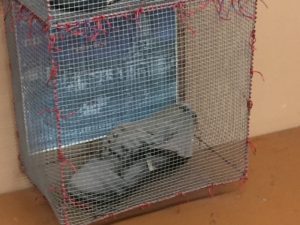
One of the shoes in above photo
The story Eina told was of a young child traveling with her mother. The mother had written the phone number of the relative in America where they would go to live with in ink on the child’s hand. Along the way, the mother died. When the little girl was finally found, she was holding her fisted hand very tight. When she finally opened it the phone number was smeared so no one could decipher the number.
Saturday, February 18, 2017
Today started when Eina, the director of the shelter where we are working took us to her church to meet some of the young teenagers that came unaccompanied to the border and are now at Southwest Key a facility for children and teens.
Three times a week, they host groups of 10+ youth to come, play games, do a prayer service and have a meal like pizza and soda. Each week groups of youth ages 3-17 come to Rico center for three hours away from the detention center. This ministry is named in honor of the priest’s nephew who was murdered in Mexico.
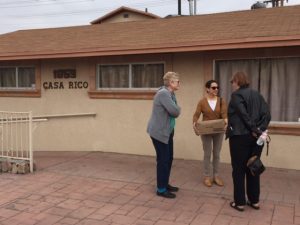

Poster at Rico Center
Seeing these young people not knowing what they have been through, what they have seen, who they left behind at home was very moving for all of us. We prayed with them and for them. When we were leaving, the young woman leading the group thanked the “white people” for coming.
After lunch, we returned to the shelter to finish up tasks to be ready for people arriving on Monday.
*In 2015, there were 75 shelters that house children along the US-Mexico border housing approximately 14,365 unaccompanied minors. Rico ministries and the detention centers collaborate to provide this program for youth in detention. Their future is unknown, they may be deported, they may reunite with another relative. If a pair of siblings comes to a center and one turns 18 they will be separated and the 18-year old will go to adult detention. You have to ask yourself what kind of a nation does this to children.
Sunday, February 19, 2017
Beautiful sunny morning in El Paso. Eina picked us up for mass at 11:30 and we drove across town to El Buen Pastor parish in Horizon City, a suburb of El Paso. The church is in one of the poorest neighborhoods of El Paso and is surrounded by a very wealthy suburb.
When we arrived. the church was already filling up 45 minutes early. I have never felt so welcome in a Catholic church. The priest welcomed us during the sermon and we were thanked by the entire community at the end of the mass. During the handshake of peace, a little 4-year old boy came over into our pew, crawled through the entire pew, and shook everyone’s hand. After the 2-hour long mass we purchased 80 tortilla’s, to deliver to the farm workers at their center in downtown El Paso.
When we arrived at the farm workers center we were greeted warmly by a man named Carlos Marentes who runs the center. The center is located on a corner where farmers will pick up day laborers to work in the fields if there is work. They have lockers and showers and sleep on the floor. At midnight, they arise and stand out on the street and wait to be picked up if there is work. Of all we have seen so far this for me was the most difficult. Grown men with skin like leather, sleeping on the floor. Maybe it was because of growing up on a farm but I saw in those men my brothers and uncles and really for no other reason than luck is there life so very different.
We introduced ourselves and they introduced themselves and the Mexican state they are from. We then joined hands and said a prayer. One of the men I was holding hands with was missing half a finger and another I am sure must have Parkinsons Disease.
The work they were doing tomorrow was picking hot chilis. Apparently, they pick by the 20-gallon container and for each one they fill they get a chip which will then be exchanged for money. The plants are low growing so if you are tall you need to crawl through the fields on your knees. We were told by the end of the day their hands feel like they have a fever. Carlos thought they may also be planting onions. To do that they poke their fingers into rock hard ground and put onion plugs in each hole. For all this earn an average of $6,700 per year (just over $500 per month).
Monday, February 20, 2107
Our day started this morning at 9:15. We cleaned this huge gathering room called the Sala. After packing up the 40+ cots and them stashing them away we sorted through a great number of toys, vacuumed the rug to get ready for the next group of travelers. We received instructions on how the intake process works.
At 1:30 an ICE van pulled up to the shelter and dropped off 4 families with a total of 9 people. Usually the processing center feeds them lunch but when they arrived they had not eaten. The group were a father and son from Brazil who were going to Boston, a young mother with a two-year old and a seven-year old from Guatemala going to Florida, a mother and her 16 year old son from Guatemala going to Nebraska, and a father and his 10 year old daughter going to North Carolina.
After a short interview one of the workers tried to call their US families waiting for them. We then helped them find a new change of clothes, show them their rooms and help them find the showers.
Every Monday a local church brings a delicious meal of beans, rice and shredded beef. One of the men that brought the food sat down at our table and talked about why he does this work. He told us that 5 years ago he was an engineer and very successful owner of a construction company when he had a heart attack. He was lying there close to death when he decided his life had to change. He decided he needed to give back because his life had been so good so he now makes and serves dinner every Monday night at the shelter.
Things we found out about the families: the Brazilian man decided he wanted to go back to Brazil. He had left two daughters behind. For him to do that he would not ever be able to get back into the US again, plus he would need to go to a detention center until a whole planeload of detainees needed to go back to Brazil. The mother with her 16-year old son was pregnant with him the last time she saw her husband. The 10-year old little girl was complaining of her legs hurting and the dad just said that yesterday they had spent the entire day running.
Tuesday, February 21, 2017
Today seemed like a long day. We started at 10:00 with a meeting to write a shopping list for the shelter and then purchase the food. Three of the families from yesterday are waiting for bus tickets sent by their receiving families. The father and his ten-year-old daughter will be leaving on the bus at 4.
The process when families arrive looks something like this. The director of the center and one of our Spanish speaking volunteers do the initial intake (finding out what papers they have, finding out who to call to receive them, etc.) From the office, they are taken to their sleeping rooms.
Next, they are taken to a used clothing room to pick out one set of clothing because they literally come with the clothes on their back. The final stop is the shower where they each are given a hygiene kit with everything they need. After they shower we give them sheets and blankets to make their beds.
Today the refugees did not get dropped off by ICE until about 3 PM so by the time they finished everything another church group had come in with the evening meal which we shared with the families. After dinner, we helped them make their beds and get settled in.
The group that arrived today were two families from Brazil. One of them was a father and his 1½ year old son. They left Brazil because they had witnessed what he called a “massacre.” His wife and their older daughter will come soon maybe tomorrow. The reason they came separately and not together was they would have been separated at the border. The father would have gone into a detention center and the mother would have come to the shelter with the children. The other two families were from Guatemala.
One was a nineteen-year old mother with a 3-month old baby the other family was an older mother with her six-year old daughter. The young mother and her baby were both extremely dehydrated so even though the baby was trying to nurse the mother had no milk to give. The baby screamed uncontrollably for most of the early evening. Although complete strangers the older mother stayed with the younger mom through the night to make sure she and the baby got plenty of fluids… amazing compassion.
We had the chance to see for the first time the electronic ankle bracelets. I had imagined maybe a small band. They are at least two inches wide, battery operated and the batteries need to be recharged on a regular basis or ICE will start looking for them.
Wednesday, February 22, 2017
Nazareth Hall got the call that 32 people (12 families) would be coming to the shelter by early afternoon so we sorted clothes, got bed linens ready and made sure we were prepared for their arrival.
This has been the largest group to come in since we came here. This time a huge white ICE bus arrived. We all felt a bit more prepared for what needed to be done.
During intake, I noticed a woman and two children. Throughout the process tears were streaming down her face and her two little girls were patting her on the back. Apparently when they arrived at the border her husband was taken away to detention and she and the girls were sent on. Everyone was once again very hungry so we served snacks while they were waiting to do their paperwork. While everyone was waiting, we noticed many of the people did not have shoe laces. Apparently, they are taken away when they arrive.
We left the shelter at 5:15 to attend a memorial mass in honor of Juan Patricio. The young man was killed outside the Annunciation House Shelter 15 years ago. We walked through luminaries that lined the sidewalk to the spot he was killed. We sat on benches in front of a makeshift altar outside. The mass was attended by many young people and many older adults.
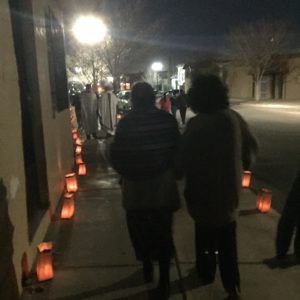
Walk for Juan Patricio
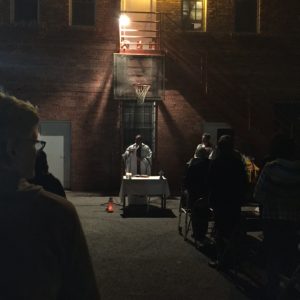
Mass at Annunciation
Many of the asylees [those seeking asylum] were leaving the shelter early in the day to go to the bus station.
Today people were leaving to be reunited with families in Maryland, Florida, New York and many more places. Because they will be riding the bus for several days and have no money the shelter sends them with a travel bag. Travel bags are made up of a blanket for each, sandwiches and fruit, snacks, water, and if they have children some sort of toy and pages to color. Some bus trips take over 36 hours. They are also given a winter coat if going to a cold climate state. Once the bags were made we started preparing for a new group of asylum seekers.
At 10:30 we got the call that 15 people (7 families) would be coming in the afternoon. After everyone was settled we put travel bags together for each family.
Tonight, we had an invitation to go to dinner at Villa Maria. This is a home for woman in crisis that need a place to stay until they can get their lives together. Women with mental issues, addiction and homelessness come to this shelter. Women from a variety of age groups live at the house. They usually stay up to two years.
Recently, however, women are being pushed to move out more quickly due to reductions in money from HUD [U.S. Department of Housing and Urban Development] The home is run on grants and a fundraiser each year. We had the opportunity to sit down with the women and enjoy a wonderful meal that they had prepared. This special place houses 22 women and offers support and counseling, job training and access to classes at a community college. It is a very calm place with a courtyard in the middle.
We are so impressed with the organization, the planning and collaboration of these shelters. All of the resources are donated and all the staffing of the centers are volunteer.
Friday, Feb. 24, 2017
We got a call this morning that Nazareth Hall will be closing today because of an inspection of the attached nursing home. All asylees will be taken to Annunciation House until further notice. We are glad to have an afternoon to rest.
Saturday, February 25, 2017
Matthew 25: 35-40
For I was hungry and you gave me food; I was thirsty
And you gave me drink; I was a stranger and you made
me welcome; naked and you clothed me; sick and you
visited me; in prison and you came to see me.
. . . I tell you solemnly, in so far as you did this to one of
the least of these brothers of mine, you did it to me.
This is the reading Rubin Garcia referred to as we met with him this morning. What we thought would be a 20-minute meeting lasted 2 hours. Rubin Garcia started working with the immigrants 40 years ago when he quit his job and with the help of the archdiocese of El Paso opened Annunciation House. He has since opened many shelters as the need arose in the immigrant and the asylee community. All of the shelters including staff are operated by donations.
He started off by saying we probably should take down the Statue of Liberty.
“Give me your tired, your poor,
Your huddled masses yearning to breathe free,
The wretched refuse of your teeming shore.
Send these, the homeless, tempest-tost to me,
I lift my lamp beside the golden door!”
The words ring hollow.
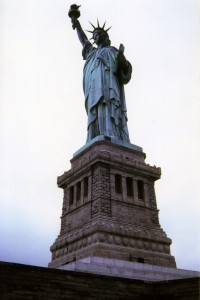
Statue of Liberty New York City harbor late June, 1972
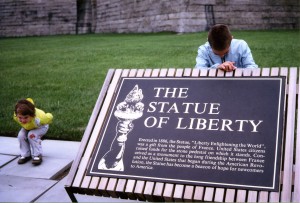
Joni and Tom Bernard at Statue of Liberty, late June, 1972 (Photos by Dick Bernard)
Mr. Garcia believes that the church has failed to raise awareness for these most vulnerable people. The clergy need to start talking about Catholic Social Teaching. After 40 years and countless groups of people coming to the border to raise their own awareness nothing has changed.
In 2014 the first wave of immigrants arrived. They arrived in south Texas and because of the numbers immigration asked Rubin Garcia to house people in El Paso. He agreed with the stipulation that he would receive no money from the government so the government would have no leverage over these people.
From October 2016 thru January 2017 the arrivals of people needing shelter went up to 1,000 refugees a week. Since the new U.S. administration has taken office the numbers have dwindled significantly. Mr. Garcia thinks people are not coming because of new U.S. immigration policy and posturing. He said there is no official policy on who gets detained, and who doesn’t. The number of government run and private detention centers has risen with the surge.
In Mr. Garcia’s words our new President changed mindsets with the power of fear and the power of repetition of lies. He repeated the terrorist threat many, many times during his campaign. Mr. Garcia said we should ask ourselves how we feel about the leader of our country given absolute freedom to lie. What do we tell our children? He compared the terrorist threats to car accidents. Since 2011 there have been 80 deaths due to terrorists and 600,000 deaths due to car accidents. So, should we ban cars? Do we fear the car companies for making cars?
He encouraged and challenged us to talk to our neighbors, both however they voted about what is already happening in America. Find out what people are afraid of in regards to immigration. He also encouraged us to sit down with our pastors and ask them how we should be responding as Christians.
His biggest fear at this time is that the U.S. will set up immigration courts at the border and no one will be granted asylum. Once turned back they will be in Mexico which does not have the accommodations to house Asylees.
Sunday, February 26, 2017
This morning we have an invitation to visit Sr. Betty and Fr. Peter in Ciudad Juarez, Mexico. We are to cross the San Antonio bridge from El Paso, Texas to Mexico. Sr. Betty assured us she would meet us at the bottom of the bridge. We had a difficult time finding the right bridge and when we asked the response was always, “You’re going to Juarez??”
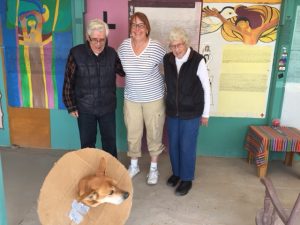
Fr. Peter and Sr. Betty and Cathy.
For over 5 years starting in 2005 Juarez was known as the murder capital of the world but in the past few years murders have dropped considerably. It was the city Pope Francis chose to visit in 2014. In any event, we were happy to see Sr. Betty at the bottom of the bridge.

Juarez, Mexico, border city of El Paso TX
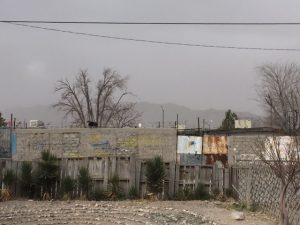
Housing from the street in Juarez
Going from El Paso to Juarez was quite something. Crumbled streets, very primitive housing almost appearing to look like the site of a city that had been in a war. We made our way by bus to the little house and yard that Sr. Betty and Fr. Peter rent.
It seems like an oasis in the middle of a desert but is located in one of the poorer boroughs of Juarez. They served us eggs from their chickens and we talked about their years working for peace and justice in Central and South America and for the past 20 years living in Juarez. At 94 years of age Fr. Peter continues to say mass at one of the boroughs in Juarez. Sr. Betty at 84 has classes for women on her porch. She took us out to her backyard to show her chickens, and the tomatoes she had just planted. In their back-yard they have a covered area where she has made memorials to various groups of people that have been murdered. She has painted murals and listed all of the names of these people. There are murals for slain journalists, murdered women, students and men and people that have died in the desert.
Juarez has had many problems over the past few years. Early in the 2000’s American companies set up Maquiladoras (factories). A Maquiladora is a factory run by a U.S. company in Mexico to take advantage of cheap labor and lax regulation. Workers usually work 6 days a week for an average of $6.00 per day. When they first began workers especially women were drawn to these factories. There is a reason we can buy cheap goods in America. Sr. Betty was telling us that one of the companies was John Deere. The same job if done in America would earn a salary of $25.00 per hour. Hardly a living wage.
Monday, February 27, 2017
It is hard to believe this is our last day to work. We got a call that Annunciation House was receiving 39 asylum seekers (12 families) and needed help. About 2 PM ICE came with two white buses and dropped them off. It was basically the same procedure as Nazareth House with the exception that the men would stay at Annunciation Shelter while the women and children would walk two blocks to Casa Theresa. Some of the Basilica group stayed to help find clothing for everyone and I went to Casa Therese to make beds. Once beds were made there was dinner for 22 that needed to be made.
We decided on a menu of macaroni & cheese with tuna and peas, spaghetti and a carrot/yellow squash combo and apples.
I started the meal and all at once was joined by a woman from Honduras who really knew how to cook. I speak basically no Spanish but could understand very well that I had not cooked the vegetables correctly. We were then joined by a woman from Brazil so none of us spoke each others language but we all knew the language of human. The Honduran woman’s 10-year old son squeezed limes to make a beverage.
When everyone had their plates filled we all joined hands and said grace. It was truly a moving moment, I will never forget.
While this was taking place, the people were registered and given medical treatment if they needed it.
The stories of some of these women will stay with us forever. One woman carried her paraplegic son on her back the entire way from Honduras. Another woman and two children had wandered through Mexico trying to get to the border for the past 3 months. They slept in woods and would beg to sleep in people’s yards. At each place, they were told they needed to leave after one night. Another young girl maybe 12 or 13 year of age said her whole body hurt and was stiff. Apparently, there is this holding facility called the icebox because it is so cold at night where people can only be detained for 24 hours but she had been there for a few days.
Over the past two weeks not once did we see a potential terrorist. These are the poorest of the poor looking for a life free of violence. They come with their children, they come to be reunited with family, they come to make a better life for their families. Everyone I talk to in Minnesota seems unaware that this is happening here at our border. How can we the richest nation on the planet turn our backs on our brothers and sisters.
Thank you to the Sisters of Loretto for their hospitality and all the people we encountered during our time in El Paso. This is an extremely generous and caring community that works tirelessly to make life better for the poor.
POSTNOTE FROM DICK: Politics and Compassion are very uneasy companions. A dozen or so years ago I came across a succinct and very powerful explanation of the relationship between politics and compassion, made by then U.S. Senator, and former U.S. Vice-President Hubert Humphrey. You can read it
here. I read it some months after a powerful visit to Haiti, and after the Iraq War had commenced. The brief paragraph or two spoke many volumes.
Donna Krisch reflects on the very human side of the migration (refugee) story.
Others with the microphones and media and levers of power much stronger than Donna or myself can better publicize “illegals”, “drugs”, and the seamy underside of immigration. The comment by Rubin Garcia (above) brings it home:
“He compared the terrorist threats to car accidents. Since 2011 there have been 80 deaths due to terrorists and 600,000 deaths due to car accidents. So, should we ban cars? Do we fear the car companies for making cars?”
Back at the beginning of the worst of the Great Depression, 1933, Franklin Delano Roosevelt made a statement that deserves repeating, over and over and over:
“The only thing we have to fear is fear itself”.
We are a nation of immigrants and descendants of immigrants. Even Native Americans, the first immigrants, initially came from somewhere else.
The only ancestor I personally knew who was an immigrant from another country was my grandfather, Henry Bernard, who came to North Dakota from Quebec about 1894. His only language when he arrived was French, and he had a first grade education. Doubtless it took years for him to speak English fluently.
He died when I was 17, and I knew him well.
Four of six of my great-grandparents immigrated to America, long before the Statue of Liberty became the welcoming beacon (and lest we forget, the Statue of Liberty was a gift from France.) My circles – all of our circles – are full of immigrants.
We do not honor ourselves by our present day fear-filled approach to people whose only sin is, as proclaimed at the Statue of Liberty, “yearning to breathe free”. We will, one day, be called to account….


